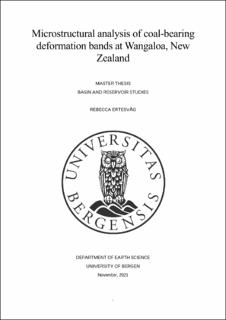| dc.description.abstract | Deformation bands are defined as tabular, millimeter to centimeter wide zones of localized strain that commonly form in porous granular rock. Deformation bands have been studied in great detail over the last four decades and are known to potentially influence the fluid flow in reservoirs. This MSc thesis attempts to characterize deformation bands with coal entrainment in siliciclastic sandstones from the Taratu Formation at Wangaloa Beach, SE New Zealand. Two sample sets were collected; sample set 1 along a deformation band cluster, with samples collected at different increments of cluster thickness, sample set 2 along two single deformation bands with samples collected at different increments of displacement. Results from extensive analysis of microscopic observations were used to determine the controlling factors on deformation mechanisms/kinematics and the microstructural evolution, as well as the microstructures of the coal and its effect on fluid flow. The main observations in both sample sets are: i) visibly reduced grain size inside the deformation band, ii) high number of survival grains inside the deformation bands, with main fracture mechanism being grain flaking and intragranular fractures. Increased pore space is observed inside the deformation bands of sample set 1 while decreased pore space is observed inside deformation bands of sample set 2. These findings suggest that the deformation mechanisms in both sample sets are an interplay between particulate flow and cataclasis. The deformation bands in sample set 1 are kinematically classified as dilatant shear bands, while deformation bands in sample set 2 are classified as compactional shear bands. Pore filling authigenic clay is present in all samples, with preferential precipitation in the host rock. This greatly affects the porosity measurements and is suggested to contribute to the increased porosity in the bands of sample set 1. Mm-thin coal seams are smeared by the deformation bands, reaching displacements up to 20 mm. BSE-SEM images reveal that the coal mainly fractures in a brittle manner depending on the coal maceral, which can result in an extensive fracture network. Increased pore space caused by volume shrinkage of the coal during burial is observed surrounding the coal fragments. These findings result in higher porosity inside the deformation band where coal is present. The coal in this study is therefore concluded to have little influence on fluid flow and does not have the same sealing potential as a clay smear. This study can contribute to a better understanding of fluid flow in reservoirs, as little mentioning of coal entrainment in deformation bands are found in the literature. That can be of relevance to projects related to production of hydrocarbons in reservoirs, CO2 storage, groundwater aquifers and geothermal reservoirs. | |
